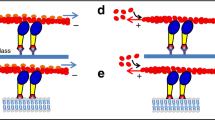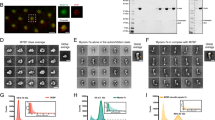Abstract
Motility in biological systems is expressed in a variety of ways, such as cytoplasmic streaming, cell shaping, nuclear migration and muscle contraction. These functions are thought to be mediated by structural proteins, for example, myosin, actin and tubulin (see ref. 1 for review). The involvement of myosin in muscle contraction is well documented and this protein is implicated in generating the cleavage forces during cytokinesis in some non-muscle cells2. Here, we report the isolation of a protein similar to myosin as judged by its biochemical and immunological properties, from the yeast Saccharomyces cerevisiae. Parts of the protein have been conserved through evolution at the protein and DNA sequence levels. The presence of this protein in the region bordering mother cell and bud, as revealed by immunofluorescence, suggests that it is involved in cell division.
This is a preview of subscription content, access via your institution
Access options
Subscribe to this journal
Receive 51 print issues and online access
$199.00 per year
only $3.90 per issue
Buy this article
- Purchase on Springer Link
- Instant access to full article PDF
Prices may be subject to local taxes which are calculated during checkout
Similar content being viewed by others
References
Korn, E. D. Proc. natn. Acad. Sci. U.S.A. 75, 588–599 (1978).
Fujiwara, K. & Pollard, T. D. J. Cell Biol. 71, 848–875 (1976).
Staudenbauer, W. L. & Orr, E. Nucleic Acids Res. 9, 3489–3603 (1981).
Macleod, A. R., Karn, J. & Brenner, S. Nature 291, 386–390 (1981).
Miller, D. M., Ortiz, I., Berliner, G. C. & Epstein, H. F. Cell 34, 477–490 (1983).
Towbin, H., Ramjoue, H.-P., Kuster, H., Liverani, D. & Gordon, J. J. biol. Chem. 257, 12709–12715 (1982).
Pollard, T. D. Meth. Enzym. 85, 331–357 (1982).
Karn, J., Brenner, S. 8 Barnett, L. Proc. natn. Acad. Sci. U.S.A. 80, 4253–4257 (1983).
Kilmartin, J. V. & Adams, A. E. M. J. Cell Biol. 98, 922–933 (1984).
Adams, A. E. M. & Pringle, J. R. J. Cell Biol. 98, 934–945 (1984).
Byers, B. & Goetsch, L. J. Cell Biol. 69, 717–721 (1976).
Byers, B. & Goetsch, L. J. Cell Biol. 70, 35a (1976).
Lanzetta, P. A., Alvarez, L. J., Reinach, P. S. & Candia, O. A. Analyt. Biochem. 100, 95–97 (1979).
Laemmli, U. K. Nature 227, 680–685 (1970).
Hancock, K. & Tsang, V. C. W. Analyt. Biochem. 133, 157–162 (1983).
Southern, E. M. J. molec. Biol. 98, 503–517 (1975).
Author information
Authors and Affiliations
Rights and permissions
About this article
Cite this article
Watts, F., Miller, D. & Orr, E. Identification of myosin heavy chain in Saccharomyces cerevisiae. Nature 316, 83–85 (1985). https://doi.org/10.1038/316083a0
Received:
Accepted:
Issue Date:
DOI: https://doi.org/10.1038/316083a0
Comments
By submitting a comment you agree to abide by our Terms and Community Guidelines. If you find something abusive or that does not comply with our terms or guidelines please flag it as inappropriate.



